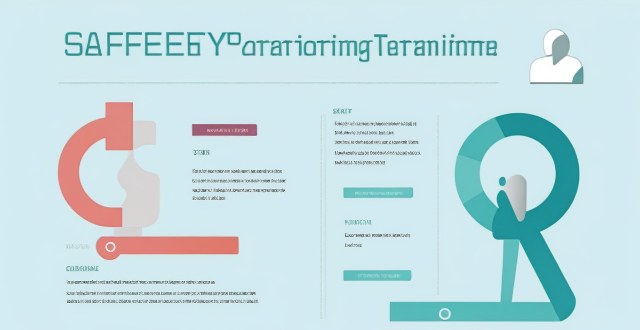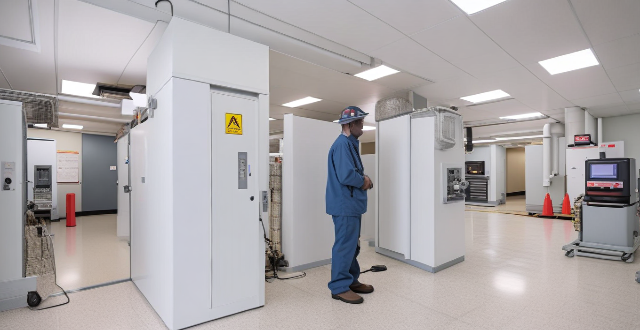Safety Employee

How can we ensure employee participation during safety drills ?
Strategies for ensuring employee participation during safety drills include clearly communicating the importance of these exercises, making them engaging and interactive, offering incentives for participation, and creating a supportive workplace culture. By implementing these strategies, employees are more likely to actively participate in safety drills, leading to improved preparedness for emergencies and a safer workplace overall.

What is the role of employee participation in maintaining workplace safety ?
**Role of Employee Participation in Maintaining Workplace Safety** Employee participation is crucial for maintaining workplace safety. It helps identify hazards, promote awareness, enhance communication, build trust, and improve compliance with safety regulations. By involving employees in safety initiatives, organizations can create a safe work environment and ensure the well-being of their workforce.

What are the legal requirements for workplace safety ?
Legal requirements for workplace safety include compliance with occupational health and safety laws, implementation of a health and safety management system, provision of personal protective equipment (PPE), reporting of injuries and illnesses, and employee participation in health and safety decisions. These measures ensure the well-being of employees and protect the company from potential legal liabilities.

How often should safety drills be conducted in the workplace ?
Regular safety drills are essential for maintaining a safe workplace. The frequency of these drills depends on the type of emergency and local regulations, but they should be frequent enough to keep employees prepared and confident in their ability to handle emergencies. Best practices for safety drills include creating realistic scenarios, encouraging employee involvement, gathering feedback, and documenting each drill.

How do safety regulations affect the hospitality industry ?
The hospitality industry is heavily impacted by safety regulations, which are crucial for maintaining the well-being of both employees and guests. These regulations cover various areas including food safety, fire safety, health and hygiene standards, and employee training. Proper handling, storage, and preparation of food items are essential to prevent foodborne illnesses, while functioning smoke detectors, fire extinguishers, and emergency exits ensure fire safety. Regular cleaning and disinfection of guest rooms, public areas, and workstations maintain high health and hygiene standards, and PPE may be required for certain tasks. Comprehensive employee training on various safety topics is vital for compliance with safety regulations. Overall, adhering to these regulations helps establishments maintain a safe environment and provide excellent service to customers.

What are the consequences of ignoring workplace safety regulations ?
Ignoring workplace safety regulations can lead to legal, financial, and human consequences for both individuals and organizations. Legal consequences include fines and penalties, legal liability, and loss of certifications. Financial consequences involve increased insurance costs, productivity losses, and reputation damage. Human consequences encompass injuries and deaths, mental health impact, and low employee morale. Prioritizing safety is crucial for protecting employees, maintaining a good reputation, and ensuring long-term success.

How can I ensure that my employees understand the meaning of various safety signs ?
To ensure that employees understand safety signs, conduct regularTo ensure that employees understand safety signs, conduct regular aids like posters and Conduct mock drills and encourage open communication through Q&A sessions and suggestion boxes. Provide access to online resources and printed materials for continuous learning.

How does corporate social responsibility impact employee satisfaction and retention ?
Corporate Social Responsibility (CSR) is a business model that focuses on balancing profitability with social responsibility. It involves companies taking actions to improve societal well-being, environmental sustainability, and ethical practices. This approach not only benefits the community and the environment but also has a significant impact on employee satisfaction and retention. The relationship between CSR and employee satisfaction includes enhanced company image and reputation, alignment with personal values, and improved work environment. The relationship between CSR and employee retention includes lower turnover rates, increased loyalty, and higher engagement levels. In conclusion, corporate social responsibility plays a crucial role in enhancing employee satisfaction and retention. By prioritizing CSR initiatives, companies can create a positive work environment, attract and retain talent, and foster loyalty among their employees. As a result, businesses that embrace CSR are more likely to have a stable workforce and achieve long-term success.

How do exercise programs impact employee productivity and job satisfaction ?
Exercise programs have a significant impact on employee productivity and job satisfaction. Companies can improve employee health, reduce stress levels, enhance team building, increase energy levels, improve mental clarity and cognitive function, reduce absenteeism and tardiness, enhance work-life balance, increase motivation and engagement, and improve company culture and retention rates by promoting a healthy lifestyle and providing opportunities for physical activity. Implementing exercise programs should be considered a valuable investment for any organization looking to improve its overall performance and success.

How do safety regulations affect the manufacturing industry ?
Safety regulations are critical in manufacturing for worker safety, environmental protection, and product quality assurance but can increase costs and administrative burden while potentially slowing innovation.

How do office layouts influence employee physical health and activity levels ?
This article explores the influence of office layouts on employee physical health and activity levels, discussing the benefits and drawbacks of open versus closed office designs, the importance of ergonomics in workstation design, and strategies for encouraging movement within the workplace. By considering these factors, employers can create environments that promote productivity while prioritizing employee well-being.

How often should workplace safety inspections be conducted ?
The frequency of workplace safety inspections is determined by factors like the nature of the business, potential hazards, and regulatory requirements. High-risk industries need more frequent checks, while low-risk ones can be less frequent. Identifying potential hazards, such as physical, chemical, or biological risks, is crucial for setting inspection schedules. Legal requirements, including OSHA guidelines and local regulations, also play a significant role. Adopting best practices like regular training, encouraging employee reports, and periodic reviews can further enhance safety. Overall, a proactive approach to safety inspections helps create a secure work environment.

How do I train my employees for emergency situations ?
Training employees for emergency situations is crucial to ensure their safety and minimize the impact of emergencies on your business. Here's a summary of the key steps involved: 1. Identify potential emergencies that could occur in your workplace, such as fire, medical emergencies, natural disasters, workplace violence, and chemical spills or hazardous materials incidents. 2. Develop an emergency plan that outlines the steps employees should take during each type of emergency. This plan should include evacuation procedures, first aid protocols, contact information for emergency services, safe locations, and procedures for accounting for all employees after an emergency. 3. Conduct regular emergency drills to ensure that employees are familiar with the emergency plan and know what to do in case of an emergency. Drills should be conducted at least annually and cover all types of emergencies identified in the emergency plan. 4. Provide training on how to use safety equipment such as fire extinguishers, first aid kits, and safety goggles. This training should be provided during new employee orientation and refresher courses should be offered regularly. 5. Encourage open communication between employees and management regarding safety concerns and suggestions for improvement. This can be done through regular safety meetings, suggestion boxes, or anonymous surveys. By following these steps, you can create a safe and prepared workforce that is ready to handle any emergency situation.

What is a safety drill and why are they important ?
A safety drill is a crucial practice session that simulates emergency situations to prepare individuals and organizations for potential emergencies by practicing evacuation procedures, using safety equipment, and following established protocols. Safety drills are important for several reasons: they familiarize people with emergency procedures, identify weaknesses in current plans, ensure compliance with regulations, maintain readiness, and promote a culture of safety.

Can you explain the Occupational Safety and Health Administration (OSHA) safety regulations ?
The text provides an introduction to OSHA safety regulations, which are enforced by the United States' federal agency, Occupational Safety and Health Administration. The goal of these regulations is to ensure safe and healthy working conditions for employees. The text covers several topics including: 1) General Duty Clause, which requires employers to provide a workplace free from recognized hazards; 2) Specific Standards, which cover various topics such as electrical wiring and equipment, hazardous chemicals and substances, and fire prevention and protection; 3) Recordkeeping, which requires employers to maintain accurate records of work-related injuries and illnesses; 4) Inspections, which are conducted by OSHA compliance officers to ensure compliance with safety regulations; and 5) Training and Education, which are provided by OSHA to help employers and employees understand their rights and responsibilities under safety regulations. The text concludes that OSHA safety regulations are essential for ensuring employee health and safety in the workplace, and employers must comply with these regulations to avoid legal consequences and create a safe working environment for their workers.

How often should personal safety training be conducted for employees ?
Personal safety training is crucial for workplace safety and should be conducted regularly. The frequency of training depends on factors such as the nature of the job, level of risk involved, and organization's policies. Recommended frequencies include annual, quarterly, monthly, and on-the-job training. By considering these factors, organizations can ensure that employees are well-prepared to handle potential accidents and emergencies.

How can employers ensure the safety of their employees in the workplace ?
How Can Employers Ensure the Safety of Their Employees in the Workplace? Employers can ensure the safety of their employees by implementing a comprehensive safety program, providing adequate safety equipment and tools, creating a culture of safety, conducting regular health and safety inspections, offering access to health care services, developing emergency response plans, and promoting ergonomics and workplace comfort.

How can businesses ensure fire safety for their employees and customers ?
Ensuring fire safety in businesses is crucial for the well-being of employees and customers, as well as for protecting assets and reputation. This comprehensive guide outlines several key measures, including installing and maintaining fire alarms and smoke detectors, keeping fire extinguishers accessible and up-to-date, developing a fire evacuation plan, training employees on fire safety procedures, controlling sources of ignition, storing flammable materials safely, and partnering with local fire departments. By following these steps, businesses can significantly enhance their fire safety and prevent potential disasters.

What are the legal requirements for displaying safety signs in a workplace ?
Legal Requirements for Displaying Safety Signs in a Workplace: Identify hazards, provide clear messages, ensure visibility, use standardized design, maintain signs, comply with regulations, and provide training.

How can a company's culture impact workplace safety ?
The text discusses the significant role of company culture in shaping workplace safety. It highlights five key aspects of a company's culture that can impact safety, including effective communication and collaboration, leadership and accountability, training and education, respectful and inclusive environment, and continuous improvement. The article emphasizes the importance of fostering a work environment where employees feel comfortable sharing information, leaders set clear expectations, regular training is provided, mutual respect is promoted, and continuous improvements are made based on feedback and data analysis. Overall, the article underscores the need for organizations to prioritize these cultural elements to create a safer work environment for their employees.

How can workplace accidents be prevented ?
Workplace accidents can be prevented through risk assessment, safety training, personal protective equipment (PPE), safe work procedures, equipment maintenance, open communication, and promoting a culture of safety. Leaders should prioritize safety and encourage employee participation in safety initiatives.

What role do food safety audits play in ensuring food quality ?
Food safety audits play a crucial role in ensuring food quality, identifying potential hazards and risks, ensuring compliance with regulations and standards, and maintaining customer trust. Companies should prepare for audits by reviewing relevant documents, conducting on-site audit activities, and following up with action plans to address any identified issues. By prioritizing food safety audits, companies can build a strong reputation for producing safe and healthy products, leading to increased customer loyalty and sales.

How can technology improve workplace safety ?
The article discusses how technology can enhance workplace safety by using wearable devices to monitor employee health, Internet of Things (IoT) for environmental control, artificial intelligence and machine learning for hazard prediction, and drones and robotics for performing dangerous tasks.

What is the importance of personal protective equipment (PPE) in the workplace ?
The Importance of Personal Protective Equipment (PPE) in the Workplace Personal protective equipment (PPE) is essential in the workplace to ensure the safety and health of employees. PPE includes items such as gloves, goggles, masks, hearing protection, and more. Here are some reasons why PPE is important: - Protection from Hazards: PPE protects workers from various hazards that may be present in their work environment, such as chemicals, biological agents, radiological materials, physical hazards, and mechanical hazards. - Compliance with Regulations: Employers are required by law to provide a safe and healthy working environment for their employees, which includes providing appropriate PPE when necessary. - Reduced Workplace Accidents: PPE can help prevent accidents in the workplace by protecting workers from harm, such as cuts, burns, and eye injuries. - Improved Employee Morale: Providing PPE shows employees that their employer values their safety and wants them to return home safely at the end of each workday, which can lead to improved morale and job satisfaction.

Are there any industry-specific considerations for implementing workplace wellness programs ?
Workplace wellness programs should consider industry-specific needs and challenges. For the manufacturing industry, safety training and ergonomic assessments are essential, while physical fitness initiatives like on-site gym facilities and fitness challenges can encourage employees to stay active. In the healthcare industry, mental health support through stress management programs and access to counseling services is crucial, along with infectious disease prevention measures such as vaccination programs and hand hygiene campaigns. The technology industry can benefit from digital detox retreats and sitting disease prevention strategies like standing desks and movement breaks. Tailoring workplace wellness programs to address industry-specific concerns can create more effective initiatives that improve employee health and productivity.

How do energy-efficient buildings affect a company's bottom line ?
Energy-efficient buildings positively impact a company's profitability by reducing energy costs, enhancing employee productivity, and improving environmental performance. These benefits include lower utility bills from reduced energy consumption, increased revenue from healthier and more productive employees, and improved corporate image that attracts talent and eco-conscious customers. Despite higher initial investment, the long-term advantages make such expenditures beneficial for sustainable business growth.

How can personal safety training be tailored to different risk levels and job roles within an organization ?
Personal safety training is crucial for protecting employees. Tailoring this training to different risk levels and job roles ensures that each employee receives the specific knowledge and skills needed for their work environment. This involves identifying risk levels, defining job roles, developing tailored training programs, incorporating practical exercises, and continuously updating and evaluating the training's effectiveness.

How can parents effectively teach their children about safety ?
Teaching children about safety is crucial for their well-being. Parents can effectively teach their children about safety by establishing clear rules, educating them about potential dangers, practicing safety drills, encouraging open communication, and modeling safe behavior. By doing so, children will develop awareness and the ability to protect themselves from potential dangers.

What safety measures are in place on cruise ships ?
Cruise ships implement various safety measures to ensure the well-being of passengers and crew, including muster drills, life-saving equipment, fire safety systems, medical facilities, security personnel, emergency response plans, navigation systems, and regular maintenance checks.

How can technology be used to enhance child safety education ?
Technology can significantly enhance child safety education through various strategies such as interactive learning applications, virtual reality experiences, online safety courses, wearable devices, and social media engagement. These tools not only make learning fun and engaging but also provide practical, real-world simulations that help children develop essential safety skills. By utilizing these modern methods, we can equip the younger generation with the knowledge and confidence needed to stay safe in a rapidly changing world.